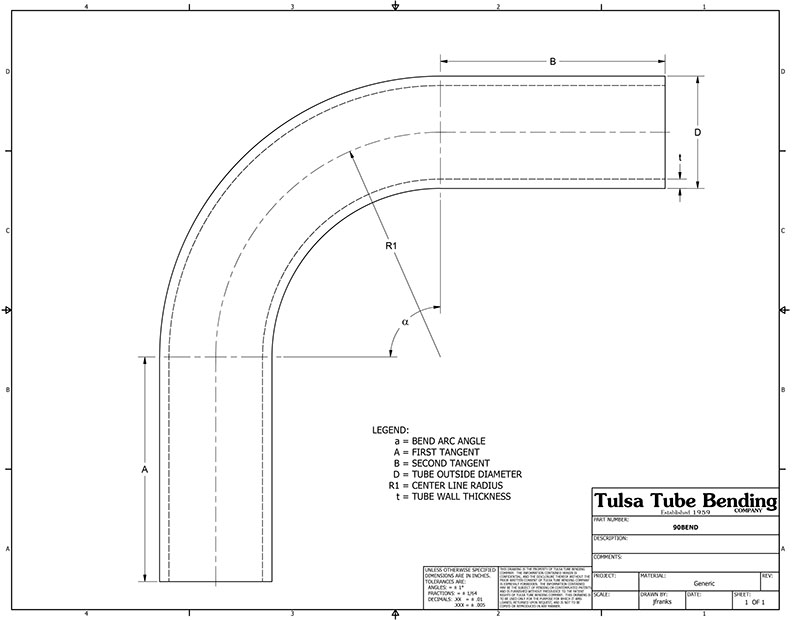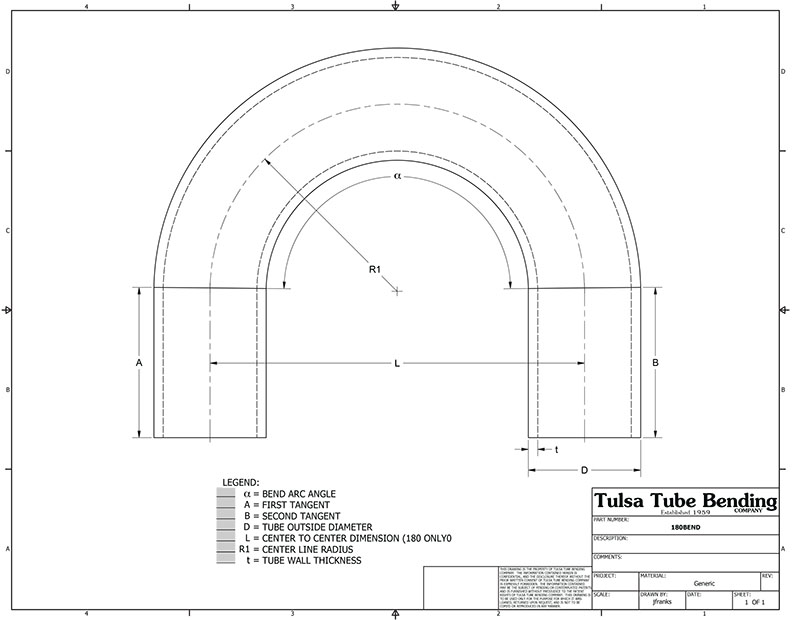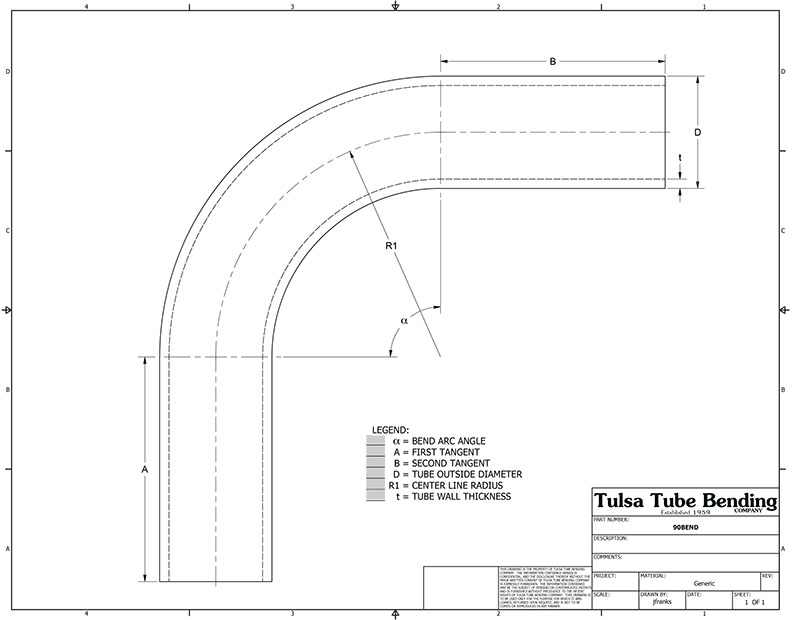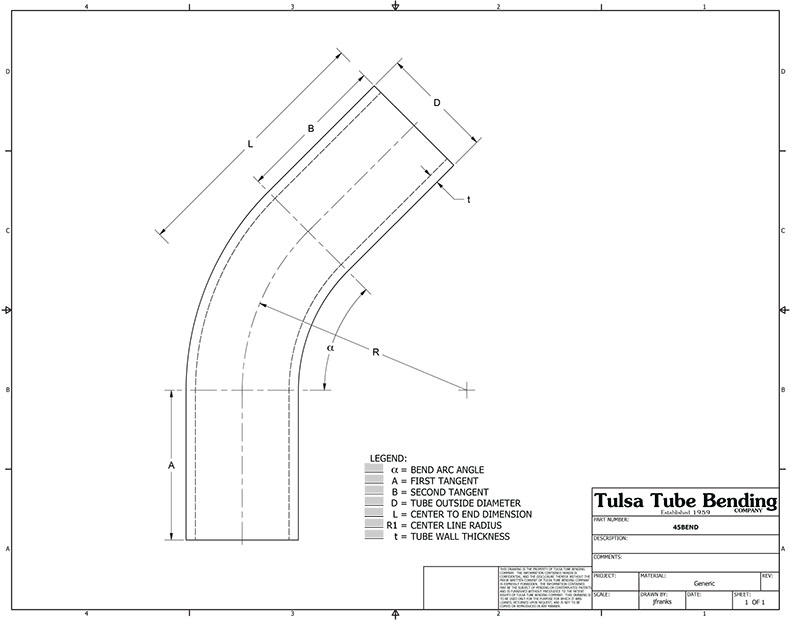Pipe Bending Terms, Definitions, and Diagrams
Arc: The curved portion of a tube or pipe bend, representing the section of the material that has been bent.
ASME B16.49: A widely recognized standard primarily used in energy, transmission, and distribution applications that outlines the manufacturing, testing, and inspection requirements for pipeline bends produced via the heat induction bending process. It emphasizes stringent controls and essential variables, including bend speed and temperature regulation, along with mandatory non-destructive and destructive testing for qualification bends.
Bending Machine: A specialized piece of equipment used to facilitate the bending of pipes and tubes, often available in different configurations such as manual, hydraulic, or CNC-controlled.
Bevel: An end preparation technique applied to tube bends or pipe bends, usually involving the creation of an angled surface on the edge for improved welding or joining.
Bending Tolerance: The acceptable deviation from the specified bend angle or radius that is considered permissible in the bending process.
Centerline Radius (CLR): The distance, typically measured in inches, from the center of curvature to the centerline axis of the tube or pipe rolling bend. CLR is an essential parameter in determining the geometry of the bend.
Circumferential Stretch: The elongation of the material around the circumference of the pipe or tube during the bending process, which can impact the wall thickness.
Cold Tube Bending: The process of shaping pipe or tube using cold working methods without the application of heat, often employed when working with materials that might be adversely affected by heat-induced changes in properties.
Degree: The angle, measured in degrees, to which the pipe or tube is bent, indicating the extent of the curvature (e.g., 45 degrees, 90 degrees, 180 degrees, etc.).
Easy Way (EZ): The bending of a rectangular tube with its shorter side lying in the plane of the tube bend, facilitating easier bending in this orientation.
Elbow: A bent pipe or tube with a predefined angle, often 45 degrees, 90 degrees, or 180 degrees.
FBE Coating: Fusion Bonded Epoxy (FBE) is a thermosetting powder commonly used to protect pipes from corrosion in pipeline construction. It involves heating and applying dry epoxy powder to the cleaned surface of the pipe, which then melts and adheres to the pipe to form a protective, durable barrier.
Grade: The specification provided by manufacturers that indicates the material type of the pipe or tube, often denoted by codes or designations such as A53B or T304W SS.
Hard Way (HW): The bending of a rectangular tube with its longer side in the plane of the tube bend, typically requiring more force and specialized equipment compared to easy way bending.
Heat Induced Distortion: Undesirable changes in the material’s microstructure and mechanical properties resulting from the heat generated during the bending process.
Induction Bending: A process used for large-radius bends, where heat is applied using an induction coil to facilitate bending without compromising the material’s structural integrity.
Inside Diameter (I.D.): The inside diameter of the tube or pipe, a critical measurement that influences the flow capacity and structural characteristics of the pipe.
ISO 9001: This certification focuses on quality management systems and standards, ensuring that the organization has implemented effective quality management processes to consistently provide products and services that meet customer and regulatory requirements.
Mandrel: A tool used to support the internal structure of the pipe or tube during the bending process, reducing wrinkling and distortion.
Minimum Tangent: The shortest straight section at the end of a pipe or tube bend required by the bending machine to form the desired bend without distortion.
Neutral Axis: The section of the pipe bend or tube bend that experiences neither compressive nor tensile stress during the bending process, often crucial for maintaining the structural integrity of the material.
Outside Diameter (O.D.): The outside diameter, measured in inches, of the tube or pipe, an important parameter for determining compatibility with fittings and other components.
Out of Plane: The deviation of the horizontal plane of a single pipe or tube bend between its tangent points, based on the theoretical center-line of the pipe or tube rolling bend.
Ovality: The deformation or flattening of the pipe or tube from its normal round shape, often resulting from the bending process and affecting the dimensional accuracy and structural integrity of the material.
Plain End: The process of making square cuts on the ends of the pipe before the bending process, without the requirement of an exact tangent length, often facilitating the subsequent bending operation.
Roll Past: A small additional arc bent beyond the specified degree in the bending process, sometimes employed to compensate for springback or to achieve the desired final shape accurately.
Rough Cut: Ends cut using methods such as an acetylene torch or arc gauge, where straightness is not a mandatory requirement, often performed to prepare the material for subsequent processes.
Square Cut: Cuts made perpendicular to the tangent of the pipe or tube bends after the bending process, ensuring precise and uniform ends for improved welding or joining operations.
Tangent: The straight portion of material on either side of the arc of rolling bends, crucial for maintaining structural integrity and facilitating accurate bending.
Tangent Point: The specific point at which the pipe or tube bend starts or ends, influencing the overall geometry and smoothness of the bend.
Taper Bore: The process of milling or grinding material from the inside diameter tangent end of pipe rolling bends to create a varied wall thickness compared to the original dimension, often necessary to meet specific design or functional requirements.
Wall Thickness: The thickness, measured in inches, of the tubular pipe material, a critical factor in determining the structural strength and pressure-bearing capacity of the pipe.
Wall Thinning: Reduction in the thickness of the pipe or tube wall at the point of bend, often a concern when achieving tight radii.
Wearbacks/Wearpads: Protective components placed on the inner or outer surface of the tube to minimize friction and prevent surface damage during the bending process.
Wrinkles: Wavy or corrugated distortions that appear on the inner radius of pipe bends or tube bends, often resulting from uneven material flow or excessive stress during the bending process.






